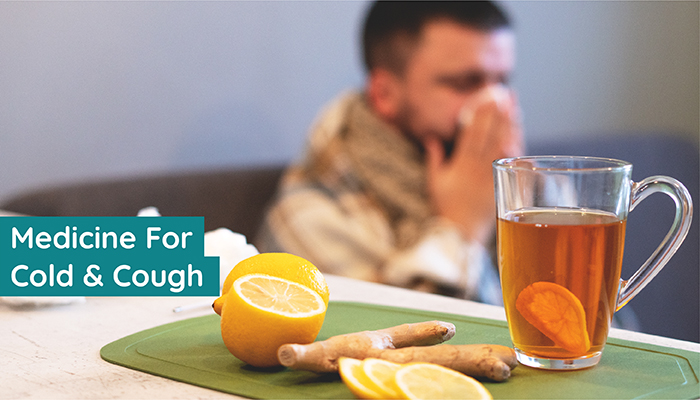Coughing is globally prevalent, and most people experience cough and cold for various reasons including fever, allergy, or a change in weather. A common cold, also known as a viral cold, is an upper respiratory infection that is caused by a virus. A viral infection of the upper respiratory tract is what is referred to as a common cold. The Rhinovirus is responsible for almost half of the prevalent colds. When a virus infects the body and overcomes the immune system, an infection results triggering cold symptoms that include clogged nose, cough, body pains, low-grade fever, headache sneezing, and sore throat. The cold & cough types of flues can be caused by more than 200 different viruses. The way a cold & cough feels, and sounds can determine the cause and possible remedies. Here is an overview of common forms of cold & cough infection, their treatments, and indications for seeking medical attention.
Common cold:
A virus causes the common cold, an upper respiratory, which is contagious. There are more than 200 viruses that can cause most types of cold and cough. Although it is possible to develop a cold & cough at any time of the year, they are more prevalent during the winter. This is because the majority of viruses that cause colds flourish in low humidity. Virus-filled droplets are released into the air when a sick person sneezes or coughs, allowing the illness to spread. If you contact a surface recently touched by an infected person and then touch your nose, mouth, or eyes, you may become ill.
Flu: Influenza,
also known as the flu, is another upper respiratory ailment. Unlike the common cold, which may occur at any time of year, the flu is often seasonal or associated with weather changes. The flu can be contracted in the same manner as most types of cold and cough–with droplets dispersed by an infected individual. A day before the onset of symptoms and up to one week following, you are contagious and experience symptoms like cold, flue and headaches. Influenza virus strains change from year to year. In contrast to the ordinary cold, influenza can progress to more dangerous conditions such as pneumonia.
Wet cough:
A wet cough is when a person coughs up phlegm or mucous. Its initial symptoms are similar to most types of cold and cough. Usually, an illness like the flu, a cold & cough, or a chest infection is to blame for wet coughs. Little quantities of bright red blood may be present in the phlegm that is coughed up by someone who has a chest infection. This blood is from the lungs and is usually not a cause for concern. One should seek medical attention if they start to cough up blood that is black, contains food, or looks like coffee grounds. Some persistent wet coughs might result from:
Treatment
: A wet cough, like most types of cold and cough, may be kept under control with warm water infused with turmeric, and the symptoms of a
can be lessened with regular steam inhalation and over-the-counter medicines including cough drops, chest massages, and painkillers. Some may require antibiotics if they have a bacterial infection that is causing their cough.
Dry Cough:
An individual may have a dry cough after a respiratory infection. Dry coughs are a typical side effect of respiratory infections like the flu and the common cold & cough. When there is little to no mucus in the throat, these coughs start to appear. A person could experience a tickle in their throat and find it difficult to quit coughing. The cough often disappears on its own, yet, if a cough persists, you may look into other underlying causes including:
Treatment:
Drinking warm water infused with turmeric, cough drops, or using cough syrup can help someone who has a dry cough stop feeling itchy. Blood in the mucus may also be present together with a cough that is associated with
, though rare. Like with all types of cold and cough, if the symptoms continue beyond a week, it is pragmatic to consult a doctor.
Coughing fit:
Whooping cough, also known as pertussis, is a bacterial condition that is very infectious. A whooping cough patient often exhibits mild cold- or flu-like symptoms before beginning to cough violently and painfully. Babies and other people with weakened immune systems may find it difficult to combat the illness or experience breathing difficulties. Within the first two weeks of the cold & cough infection, those who have this virus are most prone to spread it to others.
Treatment:
Individuals should seek medical attention right away if they have symptoms of whooping cough since early antibiotic treatment can lessen the severity of the condition.
Persistent Cough:
A cough that lasts longer than the average sickness, often 8 weeks or more, is referred to be chronic. These coughs might occasionally be an early indicator of an illness. For an appropriate diagnosis and course of therapy, a patient should visit a doctor. A persistent cough may have many reasons, such as:
Diagnosis
The vast majority of human influenza cases are clinically diagnosed. However, during low influenza activity and outside of epidemic situations, other respiratory viruses including parainfluenza, rhinovirus, respiratory syncytial virus, and adenovirus can also appear as influenza-like illness, which makes clinical differentiation of influenza from other pathogens challenging. A conclusive diagnosis requires the collection of suitable breath samples and the use of a laboratory diagnostic test. The proper collection, preservation, and transportation of respiratory specimens is the first and most important step in the laboratory detection of influenza virus infections. Direct antigen detection, viral isolation, or determination of the condition by reverse transcriptase-polymerase chain reaction (
) are popular methods for laboratory confirmation of influenza virus from throat, nasal, and nasopharyngeal secretions.


